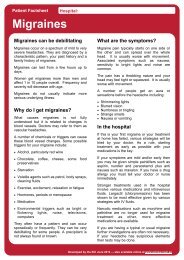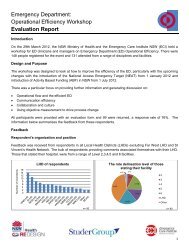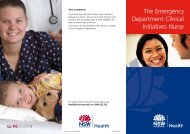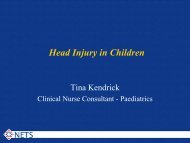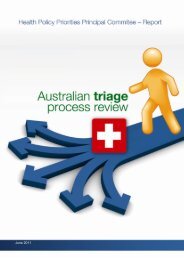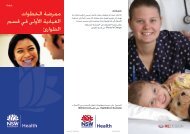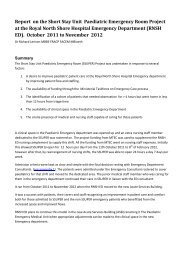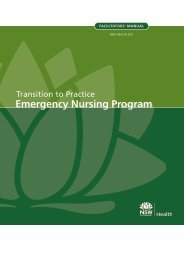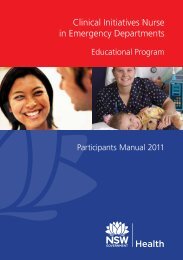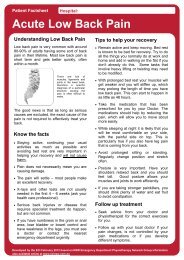Emergency Department Models of Care 2012 - NSW Health
Emergency Department Models of Care 2012 - NSW Health
Emergency Department Models of Care 2012 - NSW Health
- No tags were found...
You also want an ePaper? Increase the reach of your titles
YUMPU automatically turns print PDFs into web optimized ePapers that Google loves.
5.3 Connecting <strong>Care</strong>What is the model?Connecting <strong>Care</strong> is a program aimed at delivering more effective health management forpeople aged 16 years and over with a chronic disease. The program is focused on a number <strong>of</strong>predetermined diseases that are targeted as being <strong>of</strong> high or very high risk <strong>of</strong> unplannedhospital or ED presentation.Connecting <strong>Care</strong> links health services to improve how a patient manages their chronic conditionby better ‘<strong>Care</strong> Coordination and <strong>Health</strong> Coaching’ to develop a ‘Shared <strong>Care</strong> Plan’ for thepatient and their Local Medical Officer and health service providers. (<strong>NSW</strong> MoH, Connecting<strong>Care</strong> Program Severe Chronic Disease Management, 2006)Why use the model?The program is aimed at delivering an integrated, patient-focused, whole person service for apatient’s clinical and non-clinical functional deficits. By managing a patient’s chronic diseaseappropriately, Connecting <strong>Care</strong> aims to reduce the amount <strong>of</strong> patients presenting to the ED byhelping patients:■■■■■understand their health condition(s) betterunderstand more about their medicines and how to take themimprove their health at home and in the communityaccess the services they need, andbetter connect patients with their specialist(s), doctor and other health service providers.(<strong>NSW</strong> MoH, Connecting <strong>Care</strong> Program Severe Chronic Disease Management, 2006)Key Features ■ Priority <strong>of</strong> five diseases: Diabetes, Congestive Heart Failure, Coronary Artery Diseases,Chronic Obstructive Pulmonary Disease and Hypertension5.4 After-hours GP clinic■■■■■■■■■A proactive, coordinated approach to chronic disease management.Proactive identification, assessment, enrolment and monitoringStrong support for multidisciplinary care, care planning and care coordination.Recognition <strong>of</strong> General Practitioners as main medical care providerStrong support for patient self-managementNew regional Chronic Disease Management ServicesNew information and communication technology systems.New statewide <strong>Health</strong> Contact Centre capacityNew funding, organisational and governance structure.What is the servicemodel?Why use this service?The after-hours GP clinic is co-located to the <strong>Emergency</strong> <strong>Department</strong> and gives the communityaccess to a GP outside normal working hours in a safe hospital environment – these clinics maybe fully bulk-billed.The service is aimed at providing an alternative for patients seeking after-hours healthcare andtreatment. This service is suited to people who work full time and cannot get to a GP withinusual business hours. (<strong>NSW</strong> MoH, After hours GP clinics 2011)The after-hours GP clinic can be useful for patients as well as EDs.For patients with minor illnesses seeking treatment at the hospital, it will improve their accessto healthcare as the GP clinic will have a shorter wait time than the ED — as it does not dealwith serious illness and major trauma.<strong>Models</strong> <strong>of</strong> <strong>Emergency</strong> <strong>Care</strong> <strong>NSW</strong> HEALTH PAGE 61




